The Intel Broadwell Review Part 2: Overclocking, IPC and Generational Analysis
by Ian Cutress on August 3, 2015 8:00 AM ESTGenerational Tests: Office and Web Benchmarks
For this review, as mentioned on the front page, we retested some of the older CPUs under our new methodology. We did this testing at stock frequency as well as the IPC testing to see the ultimate real world result when you add in HyperThreading and frequency into the mix. If you recall back in our Devil’s Canyon i7-4790K review, the new high 4.4 GHz frequency of the i7-4790K was a tough one to beat for the newer architecture purely because any IPC gains are nullified by the older processor having a lot more frequency. With the Broadwell based i7-5775C being at 3.7 GHz and only 65W, this is a tough task. But what about if you are still running the Sandy Bridge based i7-2600K?
Some users will notice that in our benchmark database Bench, we keep data on the CPUs we’ve tested back over a decade and the benchmarks we were running back then. For a few of these benchmarks, such as Cinebench R10, we do actually run these on the new CPUs as well, although for the sake of brevity and relevance we tend not to put this data in the review. Well here are a few of those numbers too.
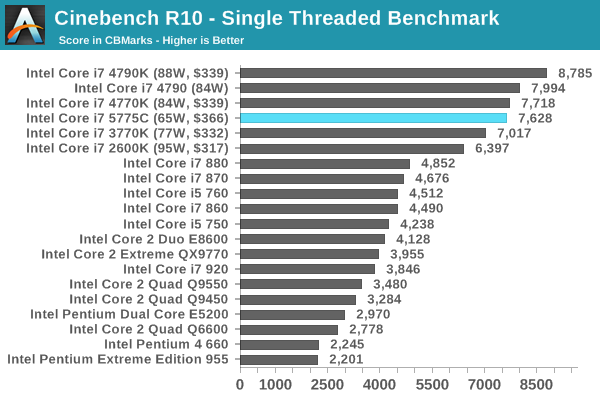
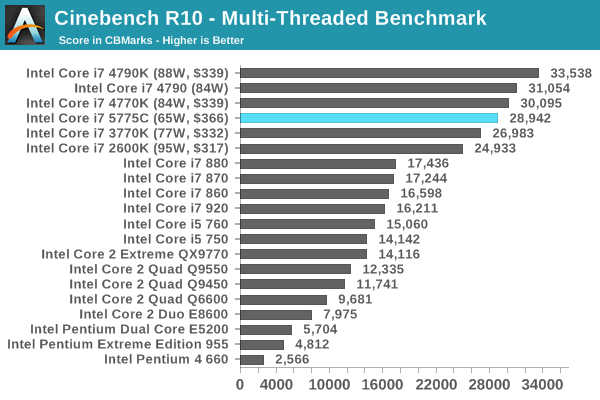


With some of these benchmarks, due to applications using new instruction sets, having the newer processors with the new instructions can make a lot of difference. Even in Cinebench R10, moving from the Core 2 Quad Q9550 to a Broadwell can get a 2.5x speed-up in this old software.
For the rest of our CPU benchmarks, here is what the landscape looks like with the most recent architectures. All of our benchmark results can also be found in our benchmark engine, Bench.
Office Performance
The dynamics of CPU Turbo modes, both Intel and AMD, can cause concern during environments with a variable threaded workload. There is also an added issue of the motherboard remaining consistent, depending on how the motherboard manufacturer wants to add in their own boosting technologies over the ones that Intel would prefer they used. In order to remain consistent, we implement an OS-level unique high performance mode on all the CPUs we test which should override any motherboard manufacturer performance mode.
Dolphin Benchmark: link
Many emulators are often bound by single thread CPU performance, and general reports tended to suggest that Haswell provided a significant boost to emulator performance. This benchmark runs a Wii program that raytraces a complex 3D scene inside the Dolphin Wii emulator. Performance on this benchmark is a good proxy of the speed of Dolphin CPU emulation, which is an intensive single core task using most aspects of a CPU. Results are given in minutes, where the Wii itself scores 17.53 minutes.

WinRAR 5.0.1: link
Our WinRAR test from 2013 is updated to the latest version of WinRAR at the start of 2014. We compress a set of 2867 files across 320 folders totaling 1.52 GB in size – 95% of these files are small typical website files, and the rest (90% of the size) are small 30 second 720p videos.
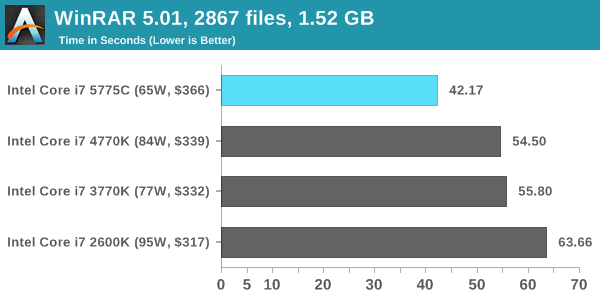
3D Particle Movement
3DPM is a self-penned benchmark, taking basic 3D movement algorithms used in Brownian Motion simulations and testing them for speed. High floating point performance, MHz and IPC wins in the single thread version, whereas the multithread version has to handle the threads and loves more cores.
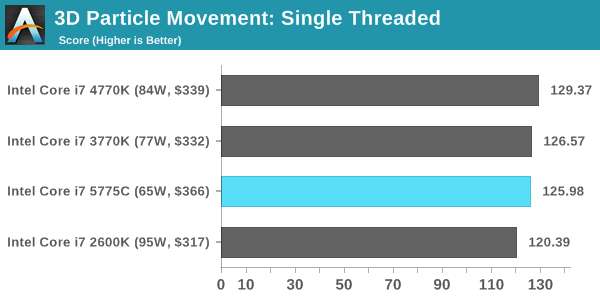
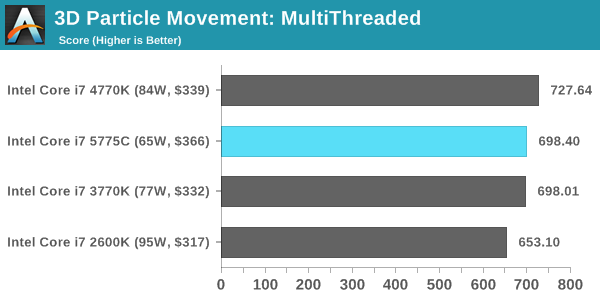
FastStone Image Viewer 4.9
FastStone is the program I use to perform quick or bulk actions on images, such as resizing, adjusting for color and cropping. In our test we take a series of 170 images in various sizes and formats and convert them all into 640x480 .gif files, maintaining the aspect ratio. FastStone does not use multithreading for this test, and results are given in seconds.
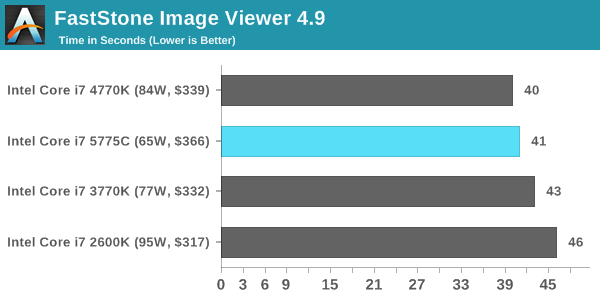
Web Benchmarks
On the lower end processors, general usability is a big factor of experience, especially as we move into the HTML5 era of web browsing. For our web benchmarks, we take four well known tests with Chrome 35 as a consistent browser.
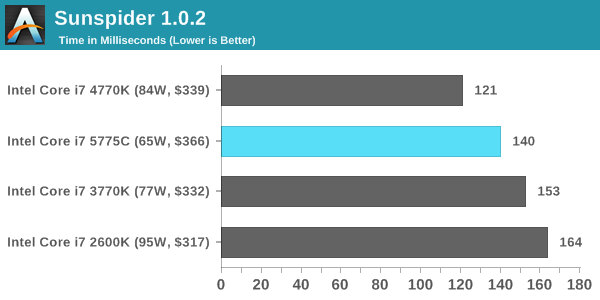
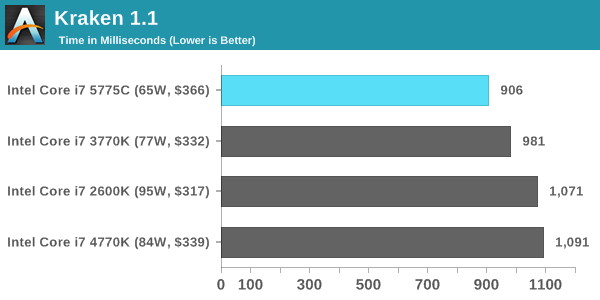
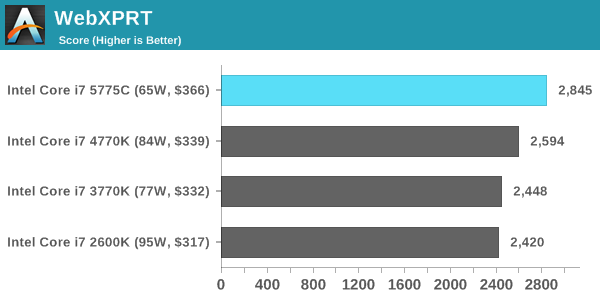
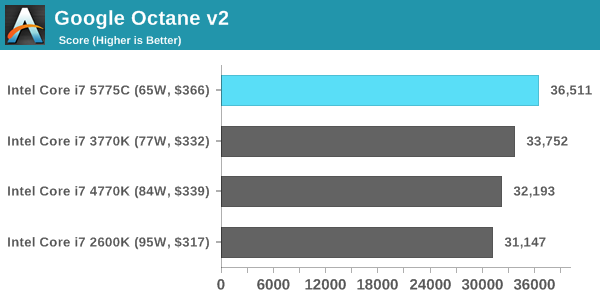










121 Comments
View All Comments
Shadowmaster625 - Monday, August 3, 2015 - link
I never understood the "pea size" method. Peas come in many different sizes. And it seems to me that the size of a typical pea is rather large. You need something standard, like a bb. They are a standard size, 0.177 caliber, and three of them in a line seems to work best.Pissedoffyouth - Monday, August 3, 2015 - link
I put a grain of rice size in the middle. get a glasses cloth and rub it on both the heatsink and the heat spreader, and rub it off. Should be a slight tinting left.Then put another grain of rice size in the middle and screw the heatsink in. Done.
You want to use the bare minimum amount of paste.
zodiacfml - Monday, August 3, 2015 - link
Very polarizing CPU. Any ideas why Intel doesn't have Crystalwell in laptops? I don't want a discrete GPU anymore in mobile due to risk of dead GPUs/Mobo after a few years.zodiacfml - Monday, August 3, 2015 - link
Oh, nevermind! I found them.extide - Monday, August 3, 2015 - link
They do, but the CPU's with Crystalwell are quite expensive, so most OEM's shy away from them because it is too expensive for a cheap laptop, and then a higher end laptop they put a dGPU in.In my next laptop, I want a Iris Pro (w/ Crystalwell) chip, and NO DGPU! I don't want the power consumption, and Iris Pro is plenty enough performance for what I do on a laptop. Unfortunately, it's kinda hard to find high-ish end laptop's with that config. :(
Gigaplex - Monday, August 3, 2015 - link
Before Broadwell, the only way to get Crystalwell was in the mobile chips.varg14 - Monday, August 3, 2015 - link
Until my pretty much 5 year old Sandy Bridge 2600k that runs between 4.5-5.0ghz PCIE 2.0 @ 8x lane speed does not bottleneck a dual GPU setup to the point it can not push at least 60FPS at 3440-1440 resolution on my 34" 21/9 LG 34UM95 monitor their is no reason to upgrade whatsoever.Also with DX12's reduced CPU overhead any new DX12 games should run great with a old Sandy CPU. Also DX12 Should greatly improve the performance of my EVGA's GTX 770 4gb Classified SLI setup since it will split frame render instead of alternate frame rendering allowing the vram to be sorta stacked since each card is only rendering half a frame instead of a whole frame allowing the 4gb of Vram on each card to act like one 8GB card.
PrinceGaz - Monday, August 3, 2015 - link
Skylake should be the big one that has been waited for since Sandy Bridge; Ivy Bridge's tick reduced overclockability because of the process node, Haswell improved IPC but added the onboard voltage regulator which made overclocking at that node still worse, and Broadwell keeps the voltage regulator whilst further focussing on lower power.I'm not saying Skylake will go to the dizzying raw gigahertz of Sandy Bridge, but two generations of tocks, and the removal of the onboard voltage regulator, and if we're lucky, the improved thermal compound used in Haswell Devil's Canyon, could together make for a significantly faster chip; one which may well see the upper ends of the 4.x GHz attainable.
Impulses - Monday, August 3, 2015 - link
Fingers crossed, if it can come near SB levels of OC I'd be complacent... Just enough for the IPC advantage not to be mitigated by raw clock speed, I'm really upgrading my 2500K for the platform anyway (M.2 in particular) but it'd be nice to get a halfway decent CPU upgrade.Aspiring Techie - Monday, August 3, 2015 - link
The Broadwell equivalent of a Sandy Bridge 5.0 GHz overclock in raw instruction throughput (assuming that Skylake doesn't have any improvement in ipc) is 4.3 GHz. A 4.6 GHz Haswell overclock is equivalent to a 4.4 GHz Broadwell. Broadwell wasn't designed for the desktop, so it isn't designed for good overclocking. If Skylake's consumer flagship has the same clocks as the 4790K with say 10% ipc over Broadwell, then at 4.4 GHz, it has will have the same instruction throughput as a 5.0 GHz Haswell or a 5.7 GHz Sandy Bridge chip. The overclock should increase as the 14nm process becomes more mature, so less voltage is needed for better clocks. If Intel does it right, then everyone will be happy (except AMD since Zen would be screwed over).